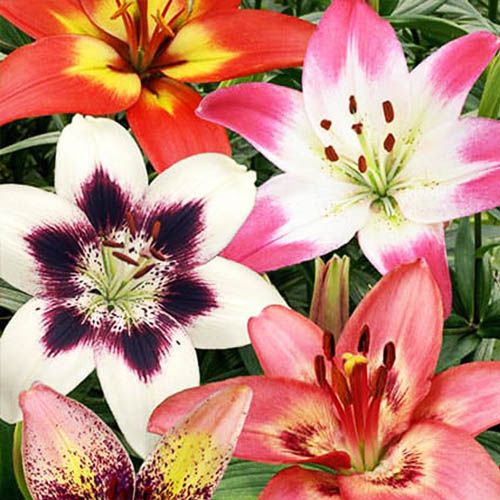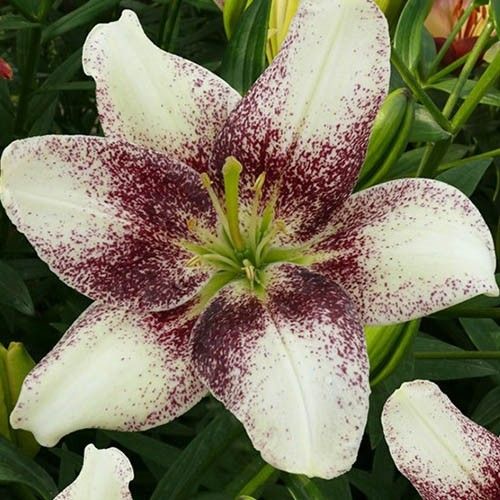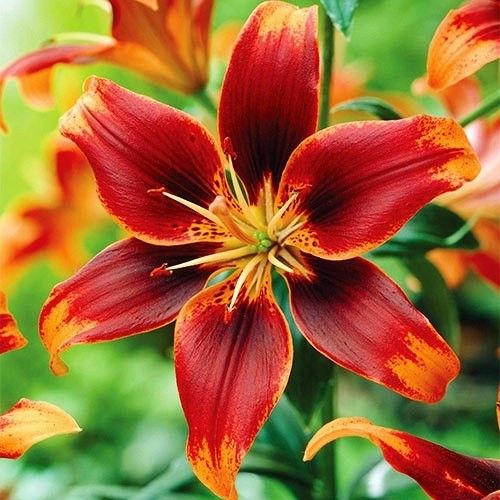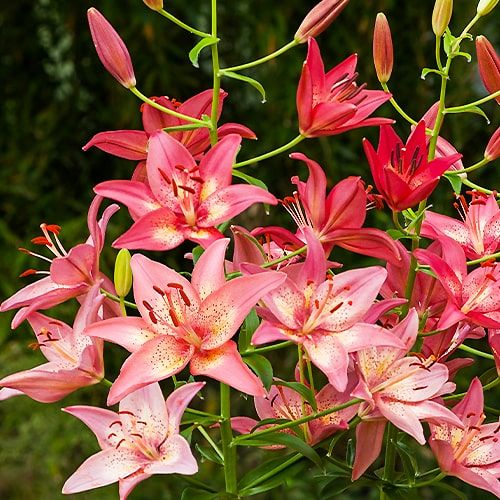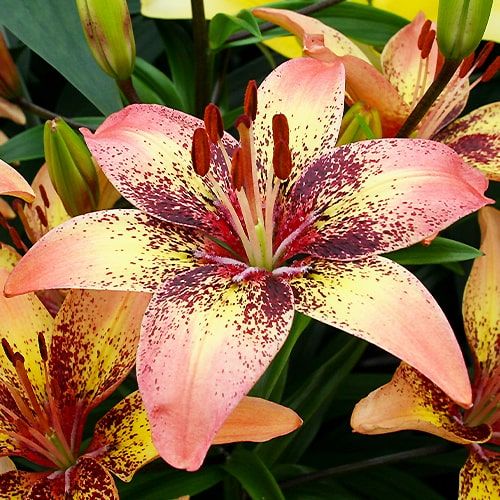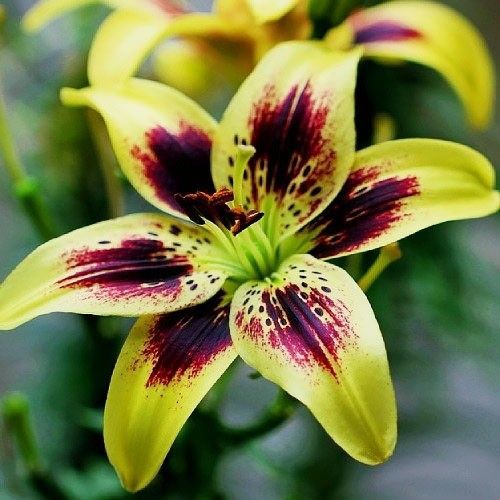
Bi-Color Lilies
Bi-Color Lilies
Last Reviews
Discover the Beauty of Bi-Color Lilies: A Guide to Growing and Buying
Bi-color lilies are stunning flowers that are sure to catch anyones eye. With their unique and striking color combinations, they make a beautiful addition to any garden or floral arrangement. Heres a guide to growing and buying bi-color lilies:
Growing Bi-Color Lilies:
Planting: Bi-color lilies are best placed in the fall, around six weeks before the ground freezes. Plant the bulbs in a hole twice as deep as the bulb height. Make sure to plant them with the pointed end facing upwards.
Soil: Lilies prefer well-drained soil that is slightly acidic, with a pH level between 6.0 and 6.5. If your soil is too alkaline, you can add sulfur to lower the pH level.
Sunlight: Lilies need at least six hours of direct sunlight each day. They can tolerate some shade, but too much shade can make them tall and spindly.
Watering: Lilies need regular watering, especially during the growing season. Water deeply, but make sure the soil doesnt become waterlogged.
Fertilizing: Lilies benefit from regular fertilization. Use a slow-release fertilizer in the spring and fall, or a liquid fertilizer every two to three weeks during the growing season.
Buying Bi-Color Lilies:
Bi-color lilies come in a wide variety of hues and designs. A variety that coordinates with your garden or floral arrangement is ideal.
Bi-color lilies are available in a range of sizes, from diminutive dwarfs to tall, towering lilies. A size that works for your garden or floral arrangement should be chosen.
Quality: Make sure the bulbs are firm, healthy, and free of mold or damage. Beware of mushy or squishy bulbs.
Source: Buy bi-color lilies from a reputable source, such as a local nursery or online retailer. Check reviews and ratings before purchasing.
Timing: Bi-color lilies are typically available for purchase in the fall, but you can also buy them in the spring. Make sure to plant them as soon as possible after purchase to ensure they have time to establish before the growing season.
What Are Bi-Color Lilies? Understanding the Unique Appeal of Multi-Colored Flowers
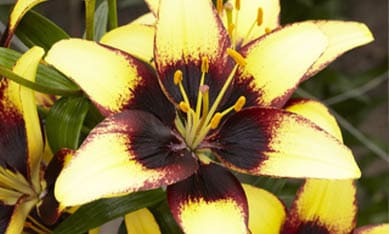
Lilies classified as bi-colors have two or more distinct colors on their petals. The colors may contrast or complement one another, producing a striking or pleasing result. Others have speckles, stripes, or spots of a different color. Some bi-color lilies have petals that are solidly colored with a different-colored center or edge. A gradient or ombre effect can be produced on the petals of bi-color lilies by using various tints of the same color.
For a variety of reasons, bi-color lilies are attractive. They draw attention and draw the eye, giving your garden or vase variety and interest. Since you can combine them with other flowers or foliage, they also give you more options for color schemes and themes. Bi-color lilies can also evoke various feelings and impressions.
Types of Bi-Color Lilies: A Rainbow of Colorful Options
Bi-colored lilies come in a wide variety, each with special characteristics and allure. Here are a few of the most popular and common ones:
- The earliest blooming and most varied lilies are Asiatic lilies. Large, star-shaped flowers of nearly every color under the sun, including numerous bi-color varieties, are their most distinctive feature. They have no scent and are simple to grow and maintain. Cappuccino,Forever Susan, Whistler, Netties Pride, and Easy Samba are examples of bi-color Asiatic lilies.
- Oriental Lilies: This group of lilies is the most fragrant and eye-catching. Their large, bowl-shaped flowers frequently have contrasting spots or edges and are available in shades of white, pink, red, or purple. They typically bloom in late summer, later than Asiatic Lilies. Since they prefer cooler temperatures and acidic soil, they require more care and attention than Asiatic Lilies. The bi-color Oriental lilies Stargazer, Casa Blanca, Mona Lisa, Tom Pouce, and Souvenir are examples.
- Orienpet lilies: These hybrids of trumpet and Oriental lilies. Their large, trumpet-shaped flowers have a strong fragrance and come in a variety of hues and patterns. They flower from the middle to the end of summer, following Asiatic lilies but before Oriental lilies. They require some maintenance and protection from pests and diseases but are more tolerant of heat and alkaline soil than Oriental lilies. Pretty Woman, Purple Prince, Night Rider, Dark Secret, and Labyrinth are some examples of bi-color Orienpet lilies.
- Species lilies: These are the wild ancestors of cultivated lilies. They have small, simple flowers that come in various shapes and colors, often with unique features such as nodding heads or curled petals. They bloom at different times depending on the species, from spring to fall. They are more adaptable and resilient than hybrid lilies, but may not be as showy or colorful. Some examples of bi-color species of lilies are Nodding Lily, Turks Cap Lily, Tiger Lily, Leopard Lily, and Madonna Lily.
How to Grow Bi-Color Lilies: Planting and Care Tips for a Stunning Garden Display
Bi-color lilies are not difficult to grow if you follow some basic guidelines. Here are some tips to help you get started:
1. Choose the right location: Bi-color lilies need at least six hours of direct sunlight per day to produce the best blooms. However, they also appreciate some afternoon shade in hot climates, as too much heat can fade their colors or cause them to wilt or droop.
2. Choose a spot with well-drained, fertile, and slightly acidic soil. Avoid planting bi-color lilies near trees or shrubs that compete for water and nutrients, or cast too much shade.
3. Plant the bulbs: Bi-color lilies are grown from bulbs, which are underground storage organs that contain the plant embryo. The most ideal time to grow bi-color lily bulbs is in the fall, before the first frost, or in early spring, after the last frost. Plant the bulbs about 6 to 8 inches deep and 8 to 12 inches apart, depending on the lilys size and type. Make sure the pointed end of the bulb faces up, and cover it with soil. Water well after planting, and apply a layer of mulch to conserve moisture and prevent weeds.
4. Care for the plants: Bi-color lilies require regular watering, especially during the growing and blooming seasons. Keep the soil moist but not soggy, and avoid wetting the foliage or flowers, as this can cause fungal diseases. Fertilize bi-color lilies once in the spring, when they start to grow, and once in the summer, when they bloom. Use a balanced fertilizer low in nitrogen and high in phosphorus and potassium, such as 5-10-10. Follow the labels instructions for dosage and application. Prune bi-color lilies by removing faded or damaged flowers, as this will encourage more blooms and prevent seed formation. Cut back the stems to about 6 inches above the ground after the foliage turns yellow and withered, usually in late fall or early winter. This will allow the bulbs to store energy for the next season.
5. Protect from pests and diseases: Bi-color lilies are susceptible to some pests and diseases that can affect their health and appearance. Some of the most common ones are:
- Lily beetles: These are bright red beetles that feed on lily leaves and flowers, leaving behind black droppings and holes. To control them, handpick them off the plants or spray them with insecticidal soap or neem oil.
- Aphids: These are small, soft-bodied insects that suck sap from the stems and buds of lilies, causing them to curl or deform. They can also transmit viral diseases that stunt or kill plants. To control them, spray them with a strong jet of water or use insecticidal soap or neem oil.
- Thrips: These are tiny, winged insects that feed on lily petals, turning them brown or silvery. They can also spread viral diseases that cause streaks or spots on leaves and flowers. To control them, use yellow sticky traps or spray them with insecticidal soap or neem oil.
- Botrytis: This is a fungal disease that causes gray mold on lily leaves and flowers, especially in humid or wet conditions. It can reduce the quality and quantity of blooms and weaken the plants. To prevent it, avoid overhead watering and provide proper air circulation around the plants. To treat it, remove infected parts and spray with a fungicide.
- Bulb rot: This is a bacterial disease that causes the softening and decay of lily bulbs, usually due to poor drainage or overwatering. It can kill plants or prevent flowering. To prevent it, plant bi-color lilies in well-drained soil and avoid overwatering. To treat it, dig up the affected bulbs and discard them.
Multi-Colored Lilies vs. Bi-Color Lilies: Whats the Difference?
Multi-colored lilies may have been mentioned to you or shown in images or catalogs. Do they differ from bicolor lilies, though? Yes and no are the answers.
Bi-color lilies and other varieties of lilies with multiple colors on their petals fall under the broader category of multi-colored lilies. A multicolored lily, for instance, might have three or more hues on each of its petals, such as red, yellow, and orange. Or, the petals may have a single color with varying hues or tones, such as light pink to dark pink.
A specific variety of multicolored lilies called bi-color lilies only have two colors on their petals. A bi-colored lily, for instance, might have white petals and purple stamens.
Bi-Color Lily Bulbs: Everything You Need to Know Before You Buy

You must first purchase some bulbs if you want to grow bi-color lilies in your garden or house. However, how can you pick the ideal bulbs for your requirements and preferences? Here are some pointers to help you make the best choice:
1. Select the type of bi-color lily: As we already mentioned, there are various species, Asiatic, Oriental, and Orienpet varieties of bi-color lilies. Every variety has unique qualities, including blooming time, fragrance, size, and color. Select a type based on your design objectives, soil type, and climate. For more variety and interest, you can also combine various types.
2. Pick the bi-color lilys color and pattern. Bi-color lilies come in a variety of colors and patterns, ranging from subdued to striking. Pick a color and pattern that matches with your personal preferences and style. You can also choose bi-color lilies that contrast with or complement your garden or house color scheme and theme. Choose bi-color lilies with blue and white petals or blue and yellow petals for a pop of color, for instance, if your garden is blue and white.
3. Select the type and number of bi-color lily bulbs you want to plant. The bulbs vary depending on the lily type and variety. Larger bulbs typically yield bigger, more flowers than smaller bulbs. Larger bulbs cost more and require more space to grow. Determine your budget and available space by selecting the bi-color lily bulbs size and number. For even greater savings and variety, bi-color lily bulbs can also be purchased in bulk or in mixed packs.
4. Select a reliable source for bi-color lily bulbs: Multicolored -color lily bulbs can be purchased from a variety of places, including online shops, catalogs, nurseries, and garden centers. Not all sources can be trusted. Select a dependable supplier of high-quality, disease-free, healthy bi-color lily bulbs. To learn more about a companys reputation and service, read previous clients reviews, ratings, or testimonials. Additionally, look for assurances or warranties that cover the effectiveness and quality of the bi-color lily bulbs.
Colorful Combinations: Pairing Bi-Color Lilies with Other Flowers for a Stunning Effect
Bi-color lilies are beautiful on their own, but they can also be paired with other flowers for a stunning effect. Here are some ideas for colorful combinations that you can try in your garden or home:
- Bi-color lilies and roses: Roses are classic companions for lilies, as they share similar shapes and fragrances. You can choose roses that match or contrast with the colors of your bi-color lilies, such as red roses with white and red bi-color lilies or yellow roses with purple and yellow bi-color lilies. You can also mix different types of roses, such as hybrid tea roses, floribunda roses, or climbing roses, for more texture and height.
- Bi-color lilies and delphiniums: Delphiniums are tall, spiky flowers that come in various shades of blue, purple, pink, or white. They add vertical interest and drama to your garden or vase, especially when paired with bi-color lilies. You can choose delphiniums that match or contrast with the colors of your bi-color lilies, such as blue delphiniums with yellow and blue bi-color lilies or purple delphiniums with white and purple bi-color lilies. You can also mix different varieties of delphiniums, such as Pacific Giant delphiniums, Belladonna delphiniums, or Candle delphiniums, for more diversity and charm.
- Bi-color lilies and daisies: Daisies are friendly, straightforward flowers that come in a range of hues and sizes. Particularly when combined with bi-color lilies, they add a touch of whimsy and innocence to your garden or vase. Choose daisies that contrast or complement the hues of your bi-color lilies, such as white daisies with pink and white bi-color lilies or yellow daisies with red and yellow bi-color lilies. For added fun and variety, mix various varieties of daisies, such as Shasta, Gerbera, or African varieties.
Frequently asked questions about Spring Flowering Bi-Color Lilies
What are bi-colour lily bulbs?
Bi-colour lily bulbs are special flower bulbs that produce lilies whose petals have two different colours. This gives the flowers a particularly beautiful and eye-catching appearance.
What colour combinations are available for Dutch bi-colour lilies?
In our shop we offer bi-colour lily bulbs in various colour combinations, including white-pink, yellow-orange and red-white. You can choose the one you like best.
When is the best time to plant bi-colour lily bulbs?
The ideal time to plant bi-colour lily bulbs is in autumn, before the ground freezes. This gives the bulbs enough time to form roots before winter sets in and they can flower in spring.
How do I care for Danish bi-colour lilies after planting?
Bi-colour lilies need well-drained soil, sufficient sunlight and regular watering. You should also take care to remove faded flowers to encourage the plant.
Can I buy bi-colour lily bulbs in your shop?
Yes, you can buy bi-colour lily bulbs in our online shop. We offer a selection of high quality bulbs in different colour combinations to beautify your garden or flower beds. Simply visit our website, select your desired bulbs and follow the easy ordering procedures.











